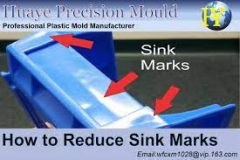When it comes to sink mark injection molding, this couldn’t be more true. Sink marks can be a real headache for manufacturers, leading to cosmetic defects and even compromising the structural integrity of your product. But fear not! In this blog post, we’ll provide some witty and helpful tips on how to prevent sink marks from appearing in your injection molded parts.
Click Here to Read Part 1st
Effective Design Tips to Avoid Sink Marks:
Optimizing the design of your part can go a long way in preventing sink marks during injection molding. By adjusting wall thicknesses to minimize differences in cooling rates, you can ensure that the plastic cools uniformly, reducing the occurrence of sink marks. Increasing injection speed also helps reduce the time that plastic is under pressure and minimizes the likelihood of sink marks.
Additionally, incorporating ribbing structures can reinforce thin areas and reduce material thickness while optimizing gate location ensures even filling of the mold cavity. Finally, consider using textured surface finishes to hide or blend in sink marks, or incorporate them into your design for a unique look. These design tips are simple yet effective ways to avoid sink marks and achieve high quality molded parts.
Utilizing Technology for Sink Mark Prevention:
Injection molding is a complex process, and preventing sink marks can be a significant challenge. Fortunately, advancements in technology have made it easier to identify potential issues and optimize the injection molding process parameters. Simulation software enables manufacturers to identify potential sink marks before production begins, allowing them to adjust the design or process accordingly.
Mold flow analysis tools ensure consistent filling of the mold cavity, minimizing sink marks. Additionally, gas-assisted injection molding or core-back molding techniques can be utilized to reduce the risk of sink marks. By utilizing these technologies, manufacturers can produce high-quality molded parts and eliminate costly rework or rejects.
Implementation of Advanced Sink Mark Injection Molding:
Advanced sink mark injection molding techniques can help prevent sink marks in plastic parts. These techniques include computer-aided engineering (CAE) software to simulate the filling and cooling process of the mold, gas-assisted injection molding, or co-injection molding with a core out to reduce the risk of sink marks. Proper design of the part, such as adding ribs or changing thickness, can also help prevent sink marks.
Partnering with an experienced injection molding manufacturer who utilizes advanced technology and techniques can ensure high-quality parts with minimal sink marks. By utilizing these advanced techniques and partnering with experts, manufacturers can produce high-quality parts that meet their customers’ strict requirements.
Click Here to Read Part 1st
Quality Control Measures:
Ensuring consistent quality is crucial in injection molding, especially when it comes to preventing sink marks. Optimal mold design, injection molding parameters, and cooling channels can work together to reduce the risk of sink marks. Incorporating fillers or additives in the material can also help improve the part structure and prevent sink marks.
Regular inspections and quality control measures during production can catch any potential issues early on, allowing for adjustments to be made before costly mistakes are made. By prioritizing quality control measures throughout the injection molding process, manufacturers can produce high-quality parts with minimal sink marks.
Material Selection and Testing:
Selecting the right material for injection molding is crucial in preventing sink marks. Using consistent quality materials and testing them thoroughly can help identify potential issues before production begins. Fillers or reinforcements can also be added to improve the strength of materials and reduce their shrinkage rate, leading to fewer defects and improved durability.
Working closely with material suppliers and conducting regular inspections ensures that only high-quality materials are used in production. Implementing these quality control measures can result in a finished product with enhanced performance, reduced defects, and increased customer satisfaction.
Consistent Molding Machine Maintenance:
Regular maintenance of injection molding machines is crucial to prevent sink marks in the finished products. Prevention is always better than cure, and that applies to molding machines as well. Consistent monitoring and maintenance of temperature, pressure, and cycle time settings are essential to ensure consistent quality output.
Neglecting these factors can lead to uneven cooling and sink marks on the parts produced. Proper cleaning and inspection of injection molds are also critical in maintaining machine performance. Trained operators should be responsible for monitoring the machines during production to ensure trouble-free operations. Implementing a quality control plan with regular testing and analysis can identify potential issues before they become major problems, ensuring efficient production processes with fewer defects.
Conclusion of Sink Mark Injection Molding:
In summary, sink marks can be a significant drawback that can mar your injection molding project’s final outcome. However, with a proper understanding of the causes of sink marks and using preventive measures such as adjusting packing pressure and time, you can reduce their occurrence.
Proper design tips and utilizing technology such as advanced sink mark injection molding can also help prevent sink marks. Lastly, quality control measures such as material selection and consistent machine maintenance ensure that your project is successful. For more information on how to prevent sink marks in injection molding, check out our blog on best practices and quality control measures.
 Plastic Injection Mold Material Guide – Advantages & Applications Of 20 Common Injection Molding Materials
Plastic Injection Mold Material Guide – Advantages & Applications Of 20 Common Injection Molding Materials  The three key factors affecting mold cost have nothing to do with materials!
The three key factors affecting mold cost have nothing to do with materials!  How to Prevent Sink Mark Injection Molding – Part 1
How to Prevent Sink Mark Injection Molding – Part 1  10 Plastic Injection Processes – Advantages, Disadvantages, And Applications Of Plastic Injection
10 Plastic Injection Processes – Advantages, Disadvantages, And Applications Of Plastic Injection